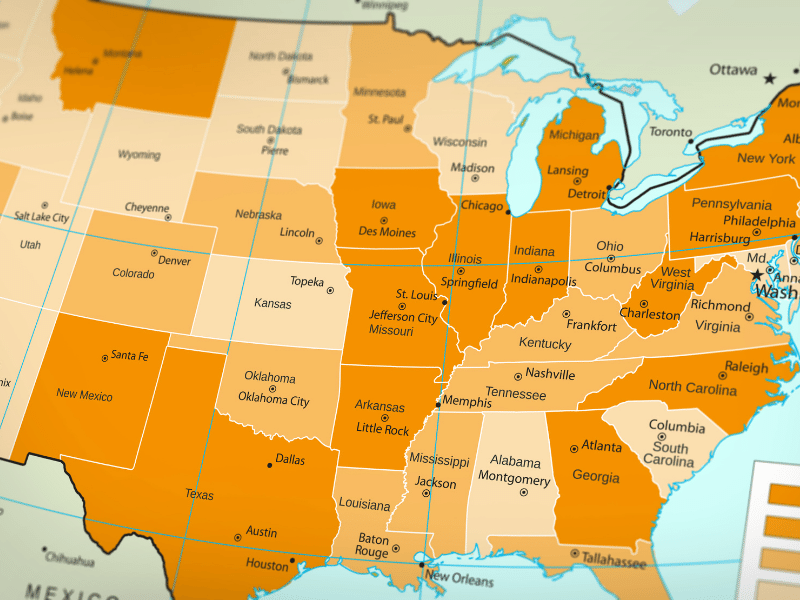
Divorce is becoming more and more common in the United States. In fact, according to recent data from the Centers for Disease Control and Prevention (CDC), the US has one of the highest divorce rates in the world.
While many factors can contribute to a divorce, it's interesting to take a look at which states have the highest rates. So without further ado, here are 10 US states with the highest divorce rates.
1. Oklahoma
The divorce rate in Oklahoma is high. According to the 2016 American Community Survey, the divorce rate in Oklahoma is 10.8%. This is higher than the national average of 9.2%. There are a variety of reasons for this high divorce rate. One reason is that Oklahoma is a no-fault state. This means that you can get a divorce without having to prove that your spouse did anything wrong. Another reason is that Oklahoma has a lot of rural areas. This means that there are not a lot of opportunities for people who are married to stay together. Finally, Oklahoma has a lot of young people. This means that there are a lot of people who get married young and then get divorced later on.
2. Arkansas
Arkansas has the sixth-highest divorce rate in the country. In 2016, there were 11.2 divorces for every 1,000 people in the state. This is a slight decrease from the 2015 rate of 11.8 divorces per 1,000 people.
The high rate of divorce in Arkansas can be partially attributed to the fact that there is no waiting period for a divorce to be granted in the state. Couples can file for divorce and be divorced within a matter of weeks, if not days. Additionally, Arkansas is a no-fault state, which means that either spouse can file for divorce without having to provide a reason.
Several factors contribute to the high divorce rate in Arkansas. One of these factors is the lack of financial stability that many families in the state experience. In addition, Arkansas is a Bible Belt state and has a strong Christian population. This religious influence can sometimes lead to marriages being less stable than those in other states.
3. Alabama
The divorce rate in Alabama is high. According to a report by the Centers for Disease Control and Prevention, the divorce rate in Alabama was 4.2 per 1,000 residents in 2016. This is higher than the national divorce rate of 3.2 per 1,000 residents.
Several factors may contribute to the high divorce rate in Alabama. One factor may be the state's Marriage Protection Act, which requires couples to wait 30 days after getting a marriage license before they can get married. This waiting period gives couples time to think about their decision and make sure they are truly committed to each other.
Another factor that may contribute to the high divorce rate in Alabama is the state's lack of no-fault divorce laws. In Alabama, couples must have a reason for getting divorced, such as adultery or abuse. This can make the divorce process more contentious and difficult.
4. Kentucky
Kentucky's divorce rate is relatively high compared to the rest of the country. In Kentucky, there are about 9.8 divorces for every 1,000 residents. This is well above the national average of 5.5 divorces per 1,000 residents.
Several factors may contribute to Kentucky's high divorce rate. One possible reason is that Kentucky is a "no-fault" divorce state. This means that spouses can get divorced without having to provide a reason.
Another factor that may contribute to Kentucky's high divorce rate is the state's strong religious tradition. Many Kentucky residents are Baptist or Catholic, and these religions place a strong emphasis on marriage and family life. Some people may find it difficult to reconcile their religious beliefs with a failed marriage.
5. Nevada
The divorce rate in Nevada is significantly higher than the national average. According to recent statistics, the divorce rate in Nevada is about 5.5 divorces per 1,000 people, while the national average is only 3.2 divorces per 1,000 people. There are several reasons for this high divorce rate, including the fact that Nevada is a no-fault state, meaning that couples can get divorced without having to provide a reason. Nevada is also known for its liberal stance on gambling and prostitution, which may contribute to the high divorce rate. Nevada is also home to many people who work in the entertainment industry, which can be a high-stress job that often leads to divorce. Whatever the reasons for the high divorce rate, it's clear that divorce is fairly common in Nevada. If you're considering getting divorced in Nevada, it's important to understand the process and what to expect.
6. West Virginia
The divorce rate in West Virginia is high. According to a study by the University of Maryland, the divorce rate in West Virginia is 47%. This is significantly higher than the national average of 33%. There are several reasons for this high divorce rate. One reason is that West Virginia is a rural state and there are not many opportunities for people to meet other singles. Another reason is that there is a lot of gambling in West Virginia and it can be difficult for marriages to survive when one or both spouses are addicted to gambling. If you are considering getting divorced in West Virginia, it is important to consult with a divorce lawyer to learn about your rights and options.
7. Wyoming
The divorce rate in Wyoming is relatively low, at 3.1 per 1,000 people. This is likely because the state has a waiting period of 18 months before a divorce can be granted. Several other factors contribute to the low divorce rate, including the fact that Wyoming is a rural state with a small population. The median income for families in Wyoming is also higher than the national average, which may signify a greater level of financial stability.
The divorce rate in Wyoming has remained relatively low over the past few years, in part due to the state's eighteen-month waiting period before a divorce can be granted. Several other factors contribute to the low divorce rate in Wyoming, including the state's rural nature and small population. In addition, the median income for families in Wyoming is higher than the national average, which may signify a greater level of financial stability. Because of these factors, couples in Wyoming may be more likely to work through marital difficulties rather than divorce.
8. Idaho
The divorce rate in Idaho is about 3.2 per 1,000 residents, which is slightly below the national average of 3.6 per 1,000 residents. Despite this relatively low divorce rate, Idaho still sees a considerable number of divorces each year. In 2016, there were over 7,600 divorces in Idaho, which accounted for nearly 5% of all marriages in the state.
9. Indiana
The divorce rate in Indiana is on the rise. In 2016, there were over 24,000 divorces in the state, which is a 3% increase from the year before. While this may not seem like a lot, it is important to remember that Indiana is a relatively small state, with a population of just over 6.5 million. This means that the divorce rate in Indiana is significantly higher than the national average.
There are several reasons for this high divorce rate. For one thing, Indiana is a conservative state, and traditional values still hold a lot of sways here. This can lead to couples feeling like they have to stay together even if they are unhappy because they don't want to be seen as failures. Additionally, there are not many resources available for people who are going through a divorce. This can make the process much more difficult than it needs to be.
10. Maine
Maine has a relatively low divorce rate compared to the rest of the United States. In 2016, the divorce rate in Maine was 3.8 per 1,000 population, while the national average was 5.2 per 1,000 population.
There are several reasons for Maine's low divorce rate. One reason may be that Maine has a strong tradition of family values. Another reason may be that Maine is a rural state with relatively few big cities, and people in rural areas tend to marry and stay married longer than people in metropolitan areas.
Whatever the reasons, Maine's low divorce rate is good news for families and the state economy. Intact families are more stable and more likely to be productive members of society. And a low divorce rate means that there are fewer single-parent households, which can be costly for taxpayers.
While the US divorce rate is high, it's important to remember that every state is different. If you're considering a divorce, it's important to talk to a lawyer in your state to understand the laws and procedures.









